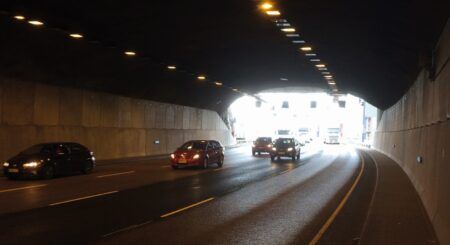New York State’s public transport agency, the Metropolitan Transportation Authority (MTA), is to pilot two programs for new technologies that are aimed at improving passenger and public safety.
Governor Andrew M Cuomo has announced that full pilot programs will launch later this year for two new MTA safety technologies: a pedestrian turn warning system and a collision avoidance system. Based on the successful completion of the pilot programs, the technologies will roll out on a city-wide basis in the fourth quarter of 2016, and will be installed on up to 1,600 buses, beginning in mid-2018. The launch of the pilot programs follows the completion of field tests for the new safety systems, during which the MTA identified key enhancements. The authority is currently working with manufacturers to implement those enhancements in time for the full launch of the pilot program.
The pedestrian warning system is automatically triggered when the bus makes a right or a left hand turn, activating an external audio warning that alerts pedestrians and cyclists that the bus is turning. External speakers are installed in an area that does not block the bus operator’s view, and the speaker volume automatically takes into consideration the ambient sound level in the vicinity of the bus. During the field test of the pedestrian turn warning system, the technology was installed on four buses, and after the trial, the MTA requested a series of improvements to the system, asking that the audio warning sound activate only on the ‘turn side’ of the bus to avoid confusion. This modification will be in place for the winter launch.
The MTA is also working with the manufacturer to develop a visual alert system that will be automatically triggered to display a visual warning to help warn customers that the bus is making a turn. This modification will be added by 2017.
The full pilot of the system will involve 200 buses. The first 40 will be in operation by the end of 2016, with the remainder rolling out during 2017.
The collision avoidance technology involves a smart sensor-based camera system that alerts the bus operator to the presence of vehicles, cyclists and pedestrians on the front and sides of the bus with visible and audible warnings. The pilot program for the collision avoidance system involved two buses operating in Brooklyn. After testing, the MTA recommended a series of improvements to enhance the technology, and as a result of the feedback, the vendor is developing vision sensors that are capable of handling the rigors of the bus wash cycle at the depots. The MTA is currently working with the vendor to implement these improvements, which will be in place in time for a launch this winter.
The full pilot for the collision avoidance system will involve 100 buses, with the first 20 in operation by the end of 2016, and the remainder on the streets during 2017.




